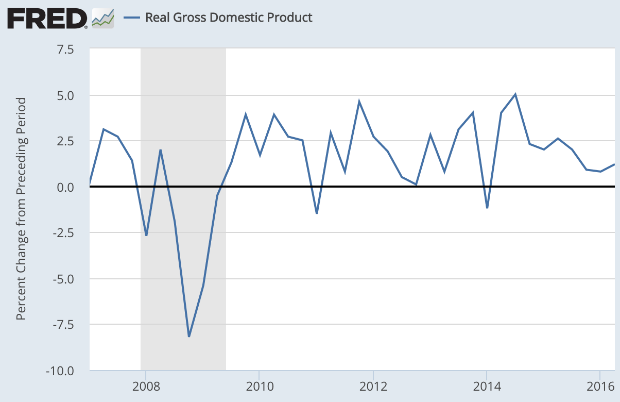Let's face it -- the U.S. economy is going nowhere fast
They are two of the scariest words in the English language, often heard as the engine room is starting to flood or the parachute fails to deploy: "Don't panic." And that was the message among economists trying to make sense of how it is, exactly, that the U.S. could be slowing, when most forecasters had expected it to be speeding up by now.
Time to lower the lifeboats? Not quite. But the economic seas are starting to look ominously rough. Let's consider why the situation is worrying.
First, it is clear that the economy is much weaker than we thought. As Deutsche Bank economists note, over the past four quarters the non-consumer portion of the economy, notably businesses (you know, the ones that hire people), has grown at a rate of -0.2 percent. That's recession territory.
A number of economists are now also ratcheting back their forecasts for full-year growth to less than 2 percent, or what many experts think is the economy's "stall speed."
Second, history shows that a downturn that starts on the "production" side of the economy, such as business investment, almost always ends in tears for consumers. Economist Charles Gave of investment advisory firm Gavekal notes that only once since 1958 (in 2012) has the non-consumer part of the economy contracted without that period later being understood to have been part of an official recession.
Third, it is also increasingly clear that the Federal Reserve didn't know how weak the economy was when it raised interest rates in December for the first time since 2006. At the time, the nation's gross domestic product -- the broadest measure of economic strength -- was thought to be growing at an annualized clip of 1.4 percent.
But as the Commerce Department's latest readout shows (there are always two revisions after the government's initial growth estimate), that turned out to be wrong -- GDP at the end of 2015 was only 0.9 percent. Oops.
Fourth, although the American consumer is a hardy breed, having helped drag the economy out of the recession despite a recovery that has been fitful at best, forecasters say that people are unlikely to continue spending with quite the same gusto as they did in the second quarter.
That would not only deprive the economy of its main engine, but also make the U.S. more vulnerable at a time the whole global economy looks wobbly.
"There is simply not much else to cushion GDP growth should consumer spending falter possibly due to an exogenous shock," Deutsche Bank wrote.
Of course, the U.S. may yet steer clear of recession. The recovery entered its seventh year in June, which is longer than the historical average for economic expansions. Yet it could continue to sail on. Interest rates remain low, a tailwind for growth, and despite its initial rate hike last December the Fed is erring on the side of caution when it comes to further monetary tightening.
In the short-term, the main reason GDP was such a dud between April and June -- businesses restocking their shelves more slowly, a pattern that has persisted for more than a year -- is likely to reverse in the months to come. That could offer the economy a modest lift.
By some key measures, meanwhile, many Americans are in a decent place, with household income rebounding from the housing crash and the job market still going strong.
The trouble is that even avoiding another full-blown slump could still leave the economy adrift and searching for direction. That might mean no stomach-churning panic in the near-term, but plenty of fear about the storms to come.
